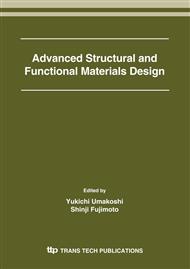[1]
Y. Lu, A. Nagata, K. Watanabe, T. Nojima, K. Sugawara, S. Hanada and S. Kamada: Physica C., 392 (2003), 453-457.
DOI: 10.1016/s0921-4534(03)01164-x
Google Scholar
[2]
S. S. He, Y. D. D. Zhang, X. Zhao, L. Zuo, J. C. C. He, K. Watanabe, T. Zhang, G. Nishijima and C. Esling: Adv. Eng. Mater., 5 (2003), 579-583.
DOI: 10.1002/adem.200300387
Google Scholar
[3]
P. Chen, H. Maeda, K. Watanabe and M. Motokawa: Physica C, 337 (2000), 160-164.
Google Scholar
[4]
P. Chen, H. Maeda, K. Watanabe, M. Motokawa, H. Kitaguchi and H. Kumakura: Physica C, 324 (1999), 172-176.
DOI: 10.1016/s0921-4534(99)00468-2
Google Scholar
[5]
P. Chen, H. Maeda, K. Kakimoto, P.X. Zhang, K. Watanabe and M. Motokawa: Physica C, 320 (1999), 96-100.
Google Scholar
[6]
M H. Zimmerman, K. T. Faber and Edwin R. Fuller, Jr.: J. Am. Ceram. Soc., 80 (1997), 2725-2729.
Google Scholar
[7]
E. Farrel, B.S. Chandrasekhar, M. R. DeGuire, M.M. Fang, V. G. Kogan, J.R. Clem and D. K. Finnemore: Phys. Rev. B, 36 (1987), 4025-4027.
Google Scholar
[8]
M. Ferreira, M.B. Maple, H. Zhou, R. R. Hake, B. W. Lee, C. L. Seaman, M. V. Kuric and R. P. Guertin: Appl. Phys. A 7, (1988), 105-110.
Google Scholar
[9]
W. Paulik, K. T. Faber and E. R. Fullar Jr.: J. Am. Ceram. Soc., 77 (1994), 454-458.
Google Scholar
[10]
K. Inoue, K. Sassa, Y. Yokogawa, Y. Sakka, M. Okido and S. Asai: Materials Transactions, JIM, 44 (2003), 1133-1137.
DOI: 10.2320/matertrans.44.1133
Google Scholar
[11]
Y. Sakka, T S. Suzuki, N. Tanabe, S. Asai and K. Kitazawa: Jpn. J. Appl. Phys., 41 (2002), 1416-1418.
Google Scholar
[12]
T. Kimura, M. Yamato, W. Koshimizu, M. Koike and T. Kawai: Langmuir, 16(2000)2, 858-861.
DOI: 10.1021/la990761j
Google Scholar
[13]
A. E. Mikelson and Ya. Kh. Karkin: J. Cryst. Growth, 52(1981), 524.
Google Scholar
[14]
H. Yasuda, K. Tokieda and I. Ohnaka: Mater. Trans. JIM, 41(2000), 1005.
Google Scholar
[15]
L. Wehrli: Phys. Kondens. Materie, 8(1968), 94.
Google Scholar
[16]
Landolt-Bornstein: Eigenschaften der Materie in ihren Aggregatzstanden, 9 teil, Magnetic Properties I, Springer, Berlin, Heidelberg, Germany, (1962), 1.
Google Scholar
[17]
Landolt-Bornstein: Eigenschaften der Materie in ihren Aggregatzstanden, 10 teil, Magnetic Properties I, Springer, Berlin, Heidelberg, Germany, (1967), 2.
Google Scholar
[18]
T. S. Suzuki, H. Otsuka, Y. Sakka, K. Hiraga and K. Kitazawa: Jpn. Powder Metal, 47(2000), 1010.
Google Scholar
[19]
T. S. Suzuki, Y. Sakka and K. Kitazawa: Adv. Eng. Mater., 3(2001), 490.
Google Scholar
[20]
M. Tahashi, M. Ishihara, K. Sassa and S. Asai: Materials Transaction JIM, 44(2003), 285-289.
Google Scholar
[21]
M. P. Anderson, D. J. Sroloviz, G. S. Great and P. S. Sahni: Act. Metallurgica, 32(1984) 783-791.
Google Scholar


